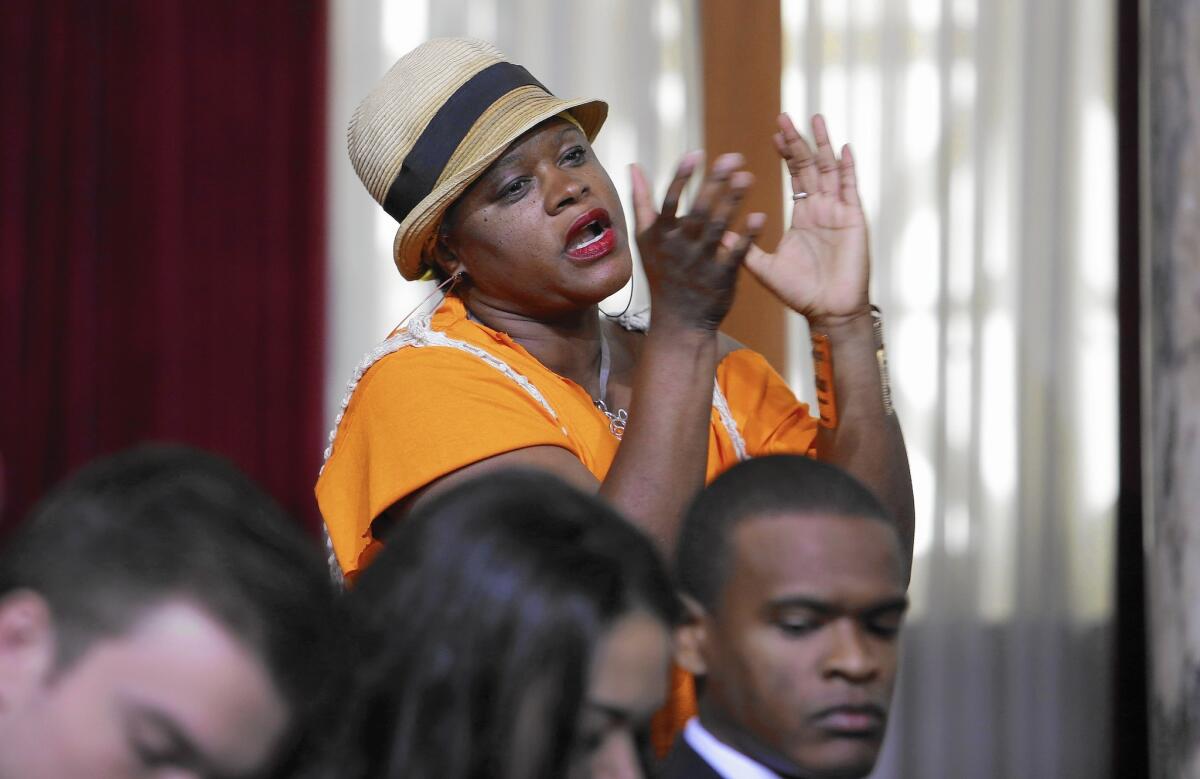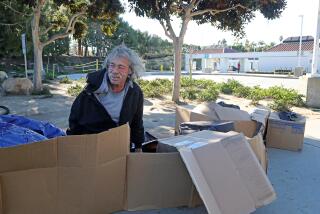L.A. City Council vote makes it easier to clear homeless camps

The Los Angeles City Council voted Tuesday to make it easier for authorities to break up the encampments that have mushroomed across Southern California along with the rising homeless population.
The council gave preliminary approval to two ordinances that would sharply reduce the warning time homeless people have to move their possessions. The laws — one covering parks, the other sidewalks — also would permit officials to immediately remove couches, chairs and oversized tents.
The more aggressive tactics come amid complaints that the encampments are unsafe and unsightly. Transient encampments and car camping grew 85% countywide in the last two years, while the city’s homeless population grew 12%, to 26,000, according to surveys by the Los Angeles Homeless Services Authority.
Councilman Gil Cedillo, who cast the lone opposition vote Tuesday, said the measures would perpetuate a failed strategy of criminalizing the homeless population.
“We spend $100 million on homelessness, and 85% of our response is law enforcement,” he said. “That tells us our strategy is not working.”
Councilmen Curren Price and Joe Buscaino said the measures strike the right balance between upholding homeless people’s rights and the public’s desire for safe, clean parks and streets.
“I’m very sensitive to the need to protect the constitutional rights of homeless people … but public spaces are public,” Buscaino said.
The city over the years has tried a variety of strategies to rein in homelessness, including a law enforcement crackdown on skid row quality-of-life infractions called the Safer Cities Initiative. But homeless numbers have grown steadily over the last four years.
The city also has a long and largely unsuccessful history of litigation over its homeless strategies. A court injunction limits the city’s ability to seize and destroy homeless people’s belongings.
Under a 2007 court settlement, the city was barred from enforcing a ban on overnight sidewalk sleeping until it built 1,250 units of supportive housing for the homeless, with half of those units downtown. The settlement followed a federal court ruling that the city’s homeless sweeps amounted to cruel and unusual punishment.
City housing officials say they expect to complete construction as soon as September, but homeless advocates are challenging the city’s claim that the units will satisfy the settlement agreement.
The city, by a broad consensus, does not have a fraction of the housing needed to shelter all the homeless. Alice Callaghan, a longtime skid row advocate, said the new measures would drive homeless people underground.
“They’re only concerned where the visibility of the homeless has become a problem,” she said. “They don’t care about homeless people.”
Skid row activists had a mixed reaction to the new ordinances, saying they are written so broadly that their effect could vary widely depending on how they are enforced.
General Jeff Page said many skid row residents would be happy to see the mess from overflowing sidewalk shantytowns removed. The neighborhood historically did not have large encampments until the city let it happen, he said, adding, “This is a problem of the city’s making. Housing storage and services is what the city needs.”
Jeffrey Briggs, a lawyer who is part of a coalition seeking to eliminate homelessness in Hollywood, said clearing the sidewalks is an important component of getting homeless people housed.
“Sidewalk enforcement efforts greatly aid the effort” to keep homeless people from taking over public passageways, he said in an email.
The new measures, which must be ratified by a second vote, cut the warning time for homeless people to move their belongings to 24 hours from 72 hours, and allow city crews to take anything that won’t fit in a 60-gallon city trash receptacle without notice. Violations will be punishable by citation or misdemeanor charges.
Seized property will be stored for 90 days at a warehouse, where owners can reclaim it. The council asked City Administrative Officer Miguel Santana to recommend a regional strategy for warehousing homeless people’s belongings, but for now, the only city-run storage facility is on skid row.
“It looks like, once again, the city is going to put enforcement way ahead of services,” said civil rights attorney Carol Sobel, who is in mediation with the city over the possessions injunction.
Councilman Mike Bonin, who represents Venice, said the ordinances were both too soft and too harsh. He proposed several amendments, including eliminating the misdemeanor penalty and allowing authorities to remove items blocking sidewalks without advance notice.
Bonin’s suggestions will be referred to the council’s new homelessness committee, whose first meeting is set for Thursday.
Council President Herb Wesson did not allow public comment on the two measures Tuesday, though protesters spoke at earlier hearings. People hoping to address the council waited three hours as members conferred with legal counsel behind closed doors.
“We had half a roomful of people who wanted to be heard,” Page said. “That’s not fair.”
Before the meeting, the Los Angeles Community Action Network, an anti-poverty group, and other skid row activists staged a demonstration outside City Hall, toting brown paper bags with slogans including “Public Space for All” and “Boo!”
Louise Mbella, Downtown Women’s Action Committee secretary, said the new ordinances are “just cruel.”
“If you negate the right to occupy public space to certain human beings, don’t call it public,” Mbella said.
Twitter: @geholland
More to Read
Sign up for Essential California
The most important California stories and recommendations in your inbox every morning.
You may occasionally receive promotional content from the Los Angeles Times.











